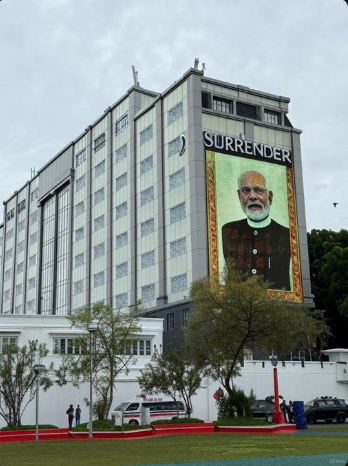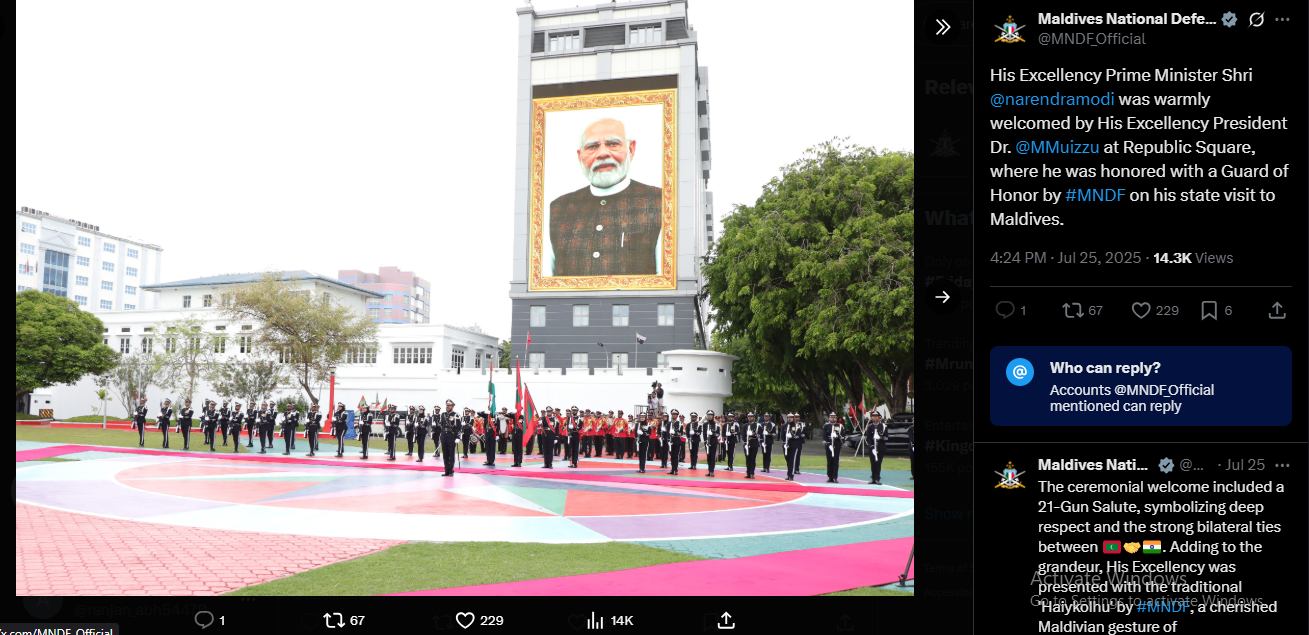#FactCheck - Viral Image of AIMIM President Asaduddin Owaisi Holding Lord Rama Portrait Proven Fake
Executive Summary:
In recent times an image showing the President of AIMIM, Asaduddin Owaisi holding a portrait of Hindu deity Lord Rama, has gone viral on different social media platforms. After conducting a reverse image search, CyberPeace Research Team then found that the picture was fake. The screenshot of the Facebook post made by Asaduddin Owaisi in 2018 reveals him holding Ambedkar’s picture. But the photo which has been morphed shows Asaduddin Owaisi holding a picture of Lord Rama with a distorted message gives totally different connotations in the political realm because in the 2024 Lok Sabha elections, Asaduddin Owaisi is a candidate from Hyderabad. This means there is a need to ensure that before sharing any information one must check it is original in order to eliminate fake news.

Claims:
AIMIM Party leader Asaduddin Owaisi standing with the painting of Hindu god Rama and the caption that reads his interest towards Hindu religion.



Fact Check:
In order to investigate the posts, we ran a reverse search of the image. We identified a photo that was shared on the official Facebook wall of the AIMIM President Asaduddin Owaisi on 7th April 2018.

Comparing the two photos we found that the painting Asaduddin Owaisi is holding is of B.R Ambedkar whereas the viral image is of Lord Rama, and the original photo was posted in the year 2018.


Hence, it was concluded that the viral image was digitally modified to spread false propaganda.
Conclusion:
The photograph of AIMIM President Asaduddin Owaisi holding up one painting of Lord Rama is fake as it has been morphed. The photo that Asaduddin Owaisi uploaded on a Facebook page on 7 Apr 2018 depicted him holding a picture of Bhimrao Ramji Ambedkar. This photograph was digitally altered and the false captions were written to give an altogether different message of Asaduddin Owaisi. It has even highlighted the necessity of fighting fake news that has spread widely through social media platforms especially during the political realm.
- Claim: AIMIM President Asaduddin Owaisi was holding a painting of the Hindu god Lord Rama in his hand.
- Claimed on: X (Formerly known as Twitter)
- Fact Check: Fake & Misleading
Related Blogs

Executive Summary:
A manipulated viral photo of a Maldivian building with an alleged oversized portrait of Indian Prime Minister Narendra Modi and the words "SURRENDER" went viral on social media. People responded with fear, indignation, and anxiety. Our research, however, showed that the image was manipulated and not authentic.

Claim:
A viral image claims that the Maldives displayed a huge portrait of PM Narendra Modi on a building front, along with the phrase “SURRENDER,” implying an act of national humiliation or submission.

Fact Check:
After a thorough examination of the viral post, we got to know that it had been altered. While the image displayed the same building, it was wrong to say it included Prime Minister Modi’s portrait along with the word “SURRENDER” shown in the viral version. We also checked the image with the Hive AI Detector, which marked it as 99.9% fake. This further confirmed that the viral image had been digitally altered.

During our research, we also found several images from Prime Minister Modi’s visit, including one of the same building displaying his portrait, shared by the official X handle of the Maldives National Defence Force (MNDF). The post mentioned “His Excellency Prime Minister Shri @narendramodi was warmly welcomed by His Excellency President Dr.@MMuizzu at Republic Square, where he was honored with a Guard of Honor by #MNDF on his state visit to Maldives.” This image, captured from a different angle, also does not feature the word “surrender.


Conclusion:
The claim that the Maldives showed a picture of PM Modi with a surrender message is incorrect and misleading. The image is altered and is being spread to mislead people and stir up controversy. Users should check the authenticity of photos before sharing.
- Claim: Viral image shows the Maldives mocking India with a surrender sign
- Claimed On: Social Media
- Fact Check: False and Misleading

Introduction
Netflix is no stranger to its subscribers being targeted by SMS and email-led phishing campaigns. But the most recent campaign has been deployed at a global scale, affecting paid users in as many as 23 countries according to cybersecurity firm Bitdefender. In this particular campaign, attackers are using the carrot-and-stick tactic of either creating a false sense of urgency or promising rewards to steal financial information and Netflix credentials. For example, users may be contacted via SMS and told that their account is being suspended due to payment failures. A fake website may be shared through a link, encouraging the individual to share sensitive information to restore their account. Once this information has been input, it is now accessible to the attackers. This can create significant stress and even financial loss for its users. Thus, they are encouraged to develop the necessary skills to recognize and respond to these threats effectively.
How The Netflix Scam Works
Users are typically contacted through SMS. Bitdefender reports that these messages may look something like this:
"NETFLIX: There was an issue processing your payment. To keep your services active, please sign in and confirm your details at: https://account-details[.]com"
On clicking the link, the victim is directed to a website designed to mimic an authentic user experience interface, containing Netflix’s logo, color scheme, and grammatically-correct text. The website uses this interface to encourage the victim to divulge sensitive personal information, such as account credentials and payment details. Since this is a phishing website, the user’s personal information becomes accessible to the attacker as soon as it is entered. This information is then sold individually or in bundles on the dark web.
Practical Steps to Stay Safe
- Know Netflix’s Customer Interface: According to Netflix, it will never ask users to share personal information including credit or debit card numbers, bank account details, and Netflix passwords. It will also never ask for payment through a third-party vendor or website.
- Verify Authenticity: Do not open links from unknown sources sent by email or sms. If unsure, access Netflix directly by typing the URL into the browser instead of clicking on links in emails or texts. If the link has been opened, do not enter any information.
- Use Netflix’s Official Support Channels: Confirm any suspicious communication through Netflix’s verified help page or app. Write to phishing@netflix.com with any complaints about such an issue.
- Contact Your Financial Institution: If you have entered your personal information into a phishing website, you should immediately reach out to your bank to block your card and change your Netflix password. Contact the authorities via www.cybercrime.gov.in or by calling the helpline at 1930 in case of loss of funds.
- Use Strong Passwords and Enable MFA/2FA: Users are advised to use a unique, strong password with multiple characters. Enable Multi-Factor Authentication or Two Factor Authentication to your accounts, if available, to add an extra level of security.
Conclusion
Phishing campaigns which are designed to gather customer data through fraudulent means often involve sending links to as many users as possible, with the aim of monetizing stolen information. Attackers exploit user trust in online platforms to steal sensitive personal information, making such campaigns more sophisticated as highlighted above. This underscores the need for users of online platforms to practice good cyber hygiene by verifying information, learning to detect suspicious information and ignoring it, and staying aware of the types of online fraud they may be exposed to.
Sources
- https://www.bitdefender.com/en-gb/blog/hotforsecurity/netflix-scam-stay-safe
- https://help.netflix.com/en/node/65674
- https://timesofindia.indiatimes.com/technology/tech-news/netflix-users-beware-this-netflix-subscription-scam-is-active-in-23-countries-how-to-spot-one-and-stay-safe/articleshow/115820070.cms

Introduction:
With improved capabilities and evasion strategies, the Vultur banking Trojan has reappeared and is a serious danger to Android users. The virus now employs numerous encrypted payloads, encrypted communication, and poses as legitimate apps. It is transmitted by trojanized dropper programs on the Google Play Store. Vultur targets victims via phone calls and SMS messages. With the help of this updated version of Vultur, attackers may take total control of compromised devices. They can perform a variety of remote control operations like install, remove, upload, and download files, halt the execution of programs, and circumvent the lock screen. The virus is now far more hazardous than it was previously because of its improved capacity to remotely access and manipulate machines.
Overview:
The Android banking malware Vultur is well-known for its ability to record screens. It was first identified by ThreatFabric in March 2021 and targets banking apps for remote control and keylogging.
The malicious apps were hosted on the Google Play Store by the Brunhilda dropper-framework, which was used for its distribution. Initial versions of the program used reputable remote access tools such as ngrok and AlphaVNC.
Hybrid attacks have been used in recent operations to disseminate the Brunhilda dropper via phone calls and SMS. The dropper uses a number of payloads to distribute an upgraded version of Vultur.
41 new Firebase Cloud Messaging (FCM) commands and seven new Command-and-Control (C2) methods are included in the most recent version of Vultur.
With the help of Android's Accessibility Services, these enhancements concentrate on remote access functionality that improves the malware's capacity to communicate with the victim's screen.
Modus operandi of Attack:
Hybrid Attack Method:
- Utilizes a phone call, two SMS messages, and trick users into installing malware.
- First SMS tricks victims into calling a certain number by claiming to have made significant, unlawful transactions, which gives the impression of urgency.
- Although there was no transaction in reality, the urgency motivates victims to act quickly.
Trozonized MacAfee App:
- The victims are told to install a trojanized version of the McAfee Security program from a given link during the phone call.
- This app looks harmless and has features similar to the original McAfee Security app, but it's actually the Brunhilda dropper.
- The victims are misled into assuming that the security software they are installing is authentic.
Execution of Vultur Payloads:
- Three payloads connected to Vultur are decrypted and executed via the Brunhilda dropper.
- Threat actors can carry out a variety of malicious operations, including keylogging and screen recording, on the victim's mobile device thanks to these payloads, which grant them total access over it.
- The infected device of the victim allows the threat actors to launch additional assaults or obtain private data.
Indication of the attack:
The symptoms of a Vultur banking Trojan infection include:
- Remote Access: This malware gives the hacker the ability to remotely use the infected device via clicking, scrolling, and swiping through Android's accessibility services.
- File Management: Through this, the malware is able to copy, share, remove, create, and locate files from devices it has infected.
- App Blocking: For instance; the malicious software can be programmed to stop the victims from opening a certain bunch of apps.
- Custom Notifications: Attackers can embed the malware with the functionality of displaying the customized notifications in the taskbar.
- Keyguard Disabling: The malware may be designed to turn off Screen Lock Guard feature so the lock screen security measure can be easily bypassed.
- Encrypted C2 Communication: The malware chooses AES data encryption, with Base64 text encoding to provide hidden traces for C2 communication.
- Payload Decryption: The malware uses native code, mostly written in C as well as C++, to decode the goods, thus, making a process of reversing more complicated.
- Spying on Financial Apps: The malware uses screen-streaming and keylogging as ways of acquiring facts about the victim’s mobile banking applications.
Indicator of Compromise:
File hash (SHA-256)
- edef007f1ca60fdf75a7d5c5ffe09f1fc3fb560153633ec18c5ddb46cc75ea21
- 89625cf2caed9028b41121c4589d9e35fa7981a2381aa293d4979b36cf5c8ff2
- 1fc81b03703d64339d1417a079720bf0480fece3d017c303d88d18c70c7aabc3
- 4fed4a42aadea8b3e937856318f9fbd056e2f46c19a6316df0660921dd5ba6c5
- 001fd4af41df8883957c515703e9b6b08e36fde3fd1d127b283ee75a32d575fc
- fc8c69bddd40a24d6d28fbf0c0d43a1a57067b19e6c3cc07e2664ef4879c221b
- 7337a79d832a57531b20b09c2fc17b4257a6d4e93fcaeb961eb7c6a95b071a06
- 7f1a344d8141e75c69a3c5cf61197f1d4b5038053fd777a68589ecdb29168e0c
- 26f9e19c2a82d2ed4d940c2ec535ff2aba8583ae3867502899a7790fe3628400
- 2a97ed20f1ae2ea5ef2b162d61279b2f9b68eba7cf27920e2a82a115fd68e31f
- c0f3cb3d837d39aa3abccada0b4ecdb840621a8539519c104b27e2a646d7d50d
- 92af567452ecd02e48a2ebc762a318ce526ab28e192e89407cac9df3c317e78d
- fa6111216966a98561a2af9e4ac97db036bcd551635be5b230995faad40b7607
- dc4f24f07d99e4e34d1f50de0535f88ea52cc62bfb520452bdd730b94d6d8c0e
- 627529bb010b98511cfa1ad1aaa08760b158f4733e2bbccfd54050838c7b7fa3
- f5ce27a49eaf59292f11af07851383e7d721a4d60019f3aceb8ca914259056af
- 5d86c9afd1d33e4affa9ba61225aded26ecaeb01755eeb861bb4db9bbb39191c
- 5724589c46f3e469dc9f048e1e2601b8d7d1bafcc54e3d9460bc0adeeada022d
- 7f1a344d8141e75c69a3c5cf61197f1d4b5038053fd777a68589ecdb29168e0c
- fd3b36455e58ba3531e8cce0326cce782723cc5d1cc0998b775e07e6c2622160
- 819044d01e8726a47fc5970efc80ceddea0ac9bf7c1c5d08b293f0ae571369a9
- 0f2f8adce0f1e1971cba5851e383846b68e5504679d916d7dad10133cc965851
- fb1e68ee3509993d0fe767b0372752d2fec8f5b0bf03d5c10a30b042a830ae1a
- d3dc4e22611ed20d700b6dd292ffddbc595c42453f18879f2ae4693a4d4d925a
- f4d7e9ec4eda034c29b8d73d479084658858f56e67909c2ffedf9223d7ca9bd2
- 7ca6989ccfb0ad0571aef7b263125410a5037976f41e17ee7c022097f827bd74
- c646c8e6a632e23a9c2e60590f012c7b5cb40340194cb0a597161676961b4de0
Command and Control Servers
- safetyfactor[.]online
- cloudmiracle[.]store
- flandria171[.]appspot[.]com (FCM)
- newyan-1e09d[.]appspot[.]com (FCM)
Droppers distribution URL’s
- mcafee[.]960232[.]com
- mcafee[.]353934[.]com
- mcafee[.]908713[.]com
- mcafee[.]784503[.]com
- mcafee[.]053105[.]com
- mcafee[.]092877[.]com
- mcafee[.]582630[.]com
- mcafee[.]581574[.]com
- mcafee[.]582342[.]com
- mcafee[.]593942[.]com
- mcafee[.]930204[.]com
Steps to be taken when your device is compromised?.
- Change the password: Vultur revealed multiple cases where threat actors can gain access to your financial and private information. To safeguard your account, reset passwords on other devices and create secure, unique passwords during the time. Instead of simply storing your password, a reputed password manager is the most secure way of storing information.
- Keep an eye on your transactions and accounts: It is advised that you regularly monitor your online accounts for any unusual or illegal activity. Keep a watch out for any irregularities, and report anything suspicious to the provider or authorities straight immediately.. Also check your credit reports and scores attentively to make sure that your identity or cards are not compromised.
- Make sure you are using identity theft protection: Many pieces of information about your identity are stored in an Android device. Cyber criminals can easily get hold of this data and make major damage to you, including stealing your money and identity. For your own protection, some of the identity theft protection services that monitor all your personal information and notify you on any unusual activity and, as well, helps you to freeze your accounts would be beneficial.
- Immediately get in touch with your banks and credit card companies: Your personal information such as credit card or bank details is of high risk to be exposed to hackers who could use them to make transactions without you knowing. You should inform your credit card and the lending bank about the situation as soon as possible. They would help you if your cards were used for fraudulent charges and your card be either frozen or canceled. Besides, they can get new cards issued.
- Make your contacts alert regarding the fraud you faced: Threat actors may access your social media or email accounts to send phishing messages or spam to people in your contact list, if they gain access to them. Moreover, they may masquerade as you and try to extort cash from you or disclose your personal information. Distributing a message to your contacts stating that they shouldn’t open or reply to any messages that look like they are not from you and look very strange or suspicious, will be a great idea.
- Make a backup and wipe all your device content in factory settings: You can always factory reset your device to ensure it is free of viruses and spyware. In other words, it will refresh Android and leave behind all your data and settings. Back up all the critical data prior to processing it and assure that everything is restored from a trustworthy source only.
Preventive measures to be taken:
- Avoid calling back to the hacker: If a hacker texts you claiming to have approved a sizable bank transaction, refrain from picking up the phone. You can always check by making a call to your own financial intuition. However, never pick up on an unknown number that someone else sends you.
- Avoid sideloading apps and shortened URLs: Try to avoid sideloading apps. That's the moment when you install apps from unofficial sources. Users may be tricked into downloading malware using short URLs.
- Be careful granting permissions: Be cautious when allowing permissions for apps. Think about whether an app really needs access to specific data or device functions.
- Limit the apps you have on your phone: On your phone, having plenty of apps might sometimes make it easier to become infected with malware. Over time, these apps may allow harmful code to enter your system, and the more programs you have to update and monitor, the greater the risk to your Android device. This is how to remove pointless apps from your Android device.
- Download apps from reputable sources: Additionally, make sure the programs you download are from reputable and authorized developers. Do your homework and read reviews before you install.
- Keep your Android device updated: With the help of software and security upgrades, your phone can automatically maintain security. Remember to install them.
- Have good antivirus software on all your devices: The best defense against malware on all of your devices is to install antivirus software. By blocking you from clicking on potentially dangerous links, antivirus software can keep malware off your devices and keep hackers from accessing your personal data.
Conclusion:
Vultur is a terrifying banking Trojan with a great deal of sophistication. It's unsettling that hackers can take complete control of your Android device, which emphasizes how crucial it is that you take precautions. It all starts with a text message in these attacks. You must take the time to independently contact your banking institution to check whether there are any issues. You may prevent having your entire device compromised and your personal information exposed by simply investing an additional few minutes.
Reference:
- https://research.nccgroup.com/2024/03/28/android-malware-vultur-expands-its-wingspan/
- https://www.threatfabric.com/blogs/vultur-v-for-vnc\
- https://www.tomsguide.com/computing/malware-adware/this-nasty-android-banking-trojan-lets-hackers-completely-hijack-your-phone-how-to-stay-safe
- https://thehackernews.com/2024/04/vultur-android-banking-trojan-returns.html?m=1
- https://www.smallbiztechnology.com/archive/2024/04/vultur-trojan-heightens-android-app-security-risks.html/
- https://securityaffairs.com/161320/malware/vultur-banking-trojan-android.html
- https://www.malwarebytes.com/blog/detections/android-trojan-spy-vultur
- https://www.scmagazine.com/brief/updated-vultur-android-banking-trojan-emerges
- https://innovatecybersecurity.com/security-threat-advisory/windows-server-updates-blamed-for-domain-controller-crashes-kb5035855-and-kb5035857/


